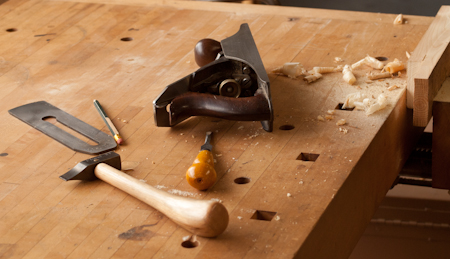 Or he would if he wasn't such a gentleman. If you recall a few blogs ago I ground up a cambered iron. I thought it would be a good idea to use a thicker iron for the cambered iron since it was for such heavy work. So I found and ground up the thickest iron I could find that was a sample and didn't need taking out of stock (I've got piles of irons that we can't sell for one reason or another). Or he would if he wasn't such a gentleman. If you recall a few blogs ago I ground up a cambered iron. I thought it would be a good idea to use a thicker iron for the cambered iron since it was for such heavy work. So I found and ground up the thickest iron I could find that was a sample and didn't need taking out of stock (I've got piles of irons that we can't sell for one reason or another).
So I ground up the iron and tried to put in in my Bedrock 604, which is a wonderful plane and normally has a pretty thick Holtey iron in it. To make it work for a heavily cambered I need enough space for the iron and a thick shaving to pass through the mouth of the plane.
Well I found out the hard way that the iron was just too thick. The problem is that the frog needs to be set pretty far back (which it was already) so that the cutting edge of the thick iron can protrude correctly without hitting the front edge of the mouth. Being cambered the iron has to be set for a heavy cut (or what's the point). I could not advance the iron deep enough without the bevel of the iron hitting the bed where the frog sits which got exposed when I backed out the frog. I fiddled with frog placement and stuff to no avail.
(Ron would be chuckling around now)
There is no way I am going to file a wider mouth on a valuable old plane. (My wife will need something of value to sell when I kick the bucket)
So I went back to put the original thick iron back in the plane. It didn't exactly fit. It was too thick.
(Ron would be laughing around now)
Actually it wasn't too thick, but if I think back to when I last adjusted the frog on the 604 - it was a very long time ago as the plane is just set up for smoothing and there has been no need to move the frog - it was a hassle. So I know the iron fits it's just getting the frog back to it's magic spot, and making sure it's correctly aligned when I tighten everything up. Which took awhile.
(It's a knee slapper now)
You see Hock irons are designed to be much thicker than a stock Stanley iron, and consequently they perform much much better. I have a Hock A2 iron in my 607 and it works wonderfully (and keeps an edge forever). Ron spent a lot of time and energy figuring out how thick you can make an iron to get great performance, but not so thick you need to modify a standard Stanley plane, or go through contortions getting it to fit.
Lots of replacement iron makers are making irons even thicker and sometimes they fit, sometimes you have to file the mouth of the plane (which I would never do to a valuable antique which the 604 is). Considering the performance I get on my 607 I don't know if the extra thickness worth the hassle.
Karl Holtey once told me that at some point thicker irons have diminishing returns - although his irons are thicker than Ron's. A really interesting experiment would be to take a plane and stick progressively thicker irons in the plane, preferably irons made by the same maker, to determine if there is a point of thickness where the hassle factor isn't worth the cost or effort.
You can check out bench plane irons and other stuff made by Hock Tools here.
You can visit Ron's website here.
Note: if you don't have the urge to replace your plane irons with a hock iron you can get a major improvement on performance just by using one of his cap irons for far less cost.
I put the cambered iron in my Clifton which normally uses a thick iron although I did have to move the frog to get a wider mouth and be careful how deep a cut I make.
|
 Joel's Blog
Joel's Blog Built-It Blog
Built-It Blog Video Roundup
Video Roundup Classes & Events
Classes & Events Work Magazine
Work Magazine






















 Or he would if he wasn't such a gentleman. If you recall a few blogs ago I ground up a
Or he would if he wasn't such a gentleman. If you recall a few blogs ago I ground up a
One of these days a true scrub will be added like a a LN 40-1/2, but until then the ugly duckling #5 with stock iron will get the call for my scrubbing needs.
http://www.leevalley.com/US/wood/page.aspx?p=49588&cat=1,230,41182